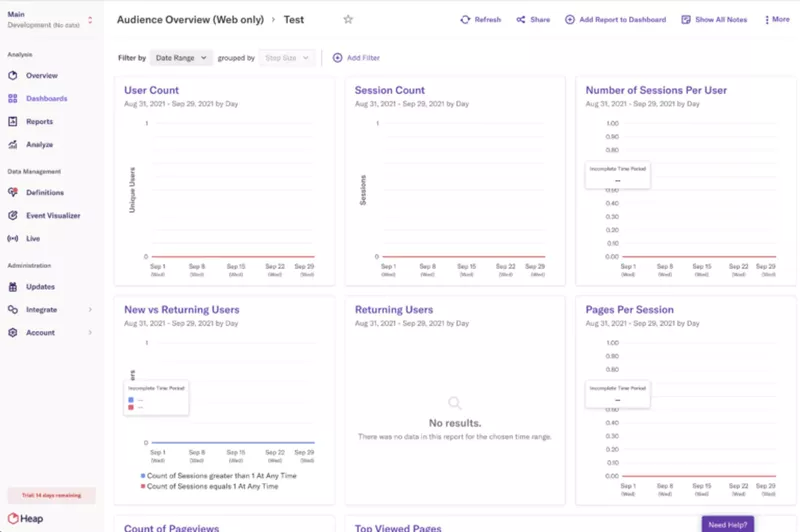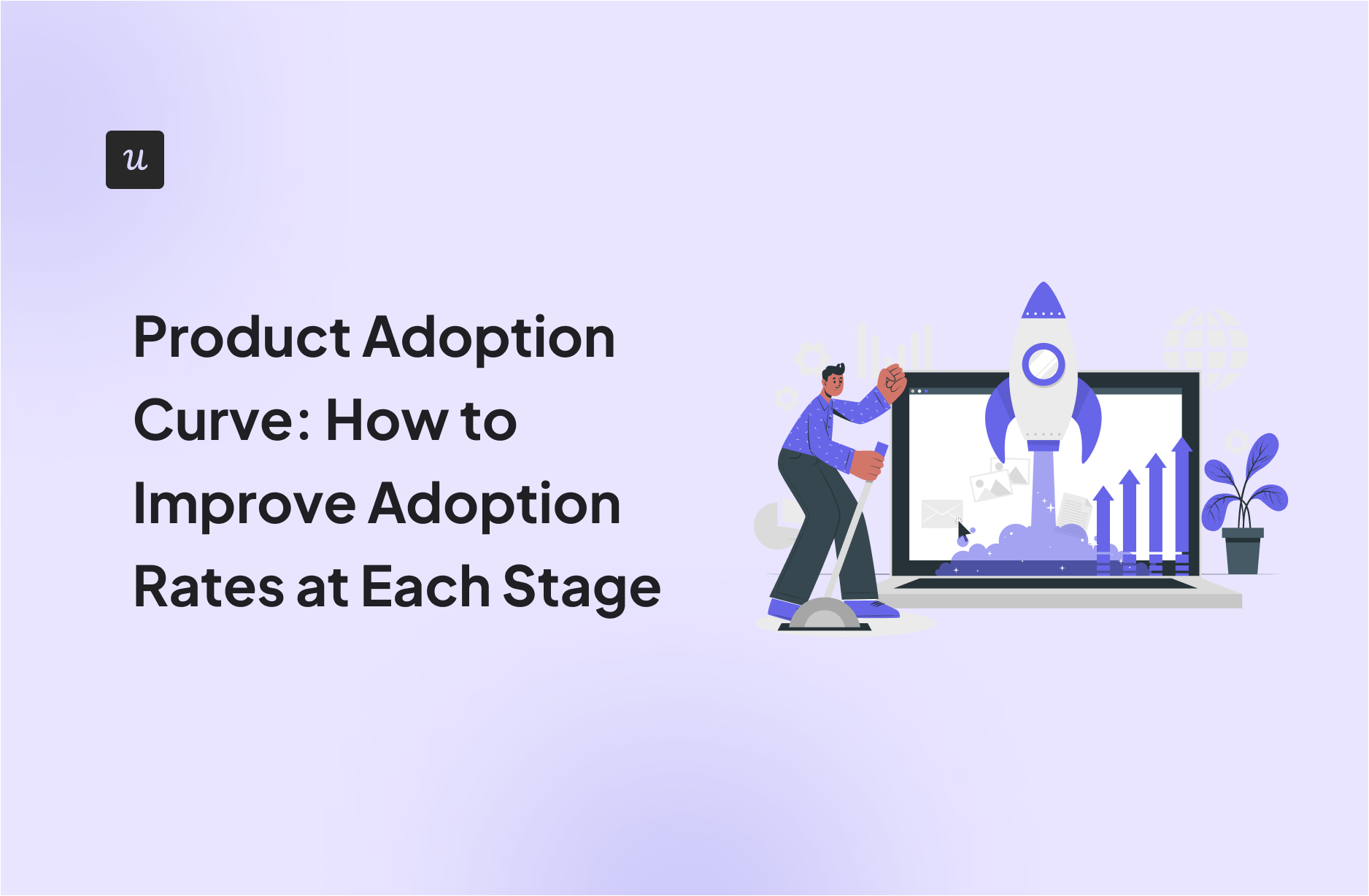
Product Adoption Curve: How to Improve Adoption Rates at Each Stage
Imagine trying to convince your grandma to start using Snapchat before your 16-year-old sister or niece. It seems impossible, right? Both of them may become Snapchat users eventually but the 16-year-old is more likely to adopt it sooner. And that’s because of the product adoption curve.
The product adoption curve shows how a product is adopted through multiple segments of the market. Understanding this lets you craft a product marketing strategy for every stage of product adoption. It’s your best shot at getting widespread use for your new technology.
Read on to find out how to use the product adoption curve to your advantage.
Try Userpilot Now
See Why 1,000+ Teams Choose Userpilot

Product adoption curve summary
- The product adoption curve illustrates when each customer segment is most likely to adopt new technology so you can make the most of each stage of your product’s growth.
- The five stages of the product adoption curve are innovators, and early adopters, early majority, late majority, and laggards, with a chasm between the early adopters and early majority.
- The product adoption curve is crucial in helping product management to understand how to tackle the chasm between early adopters and the early majority.
- For product marketing, the product adoption curve is key to understanding the shift in messaging that’s required to cross the chasm between early adopters and the early majority.
- You can improve product adoption among each segment of the product adoption curve based on their characteristics and what they look for in a product.
- Heap’s Illuminate feature is ideal for automatically identifying additional necessary steps in your user experience to increase product adoption.
- Userpilot’s features empower businesses to create a seamless and personalized user experience, guide users through the onboarding process through in-app tutorials, drive feature adoption, and gather valuable insights to optimize the product adoption process and user satisfaction.
What is the product adoption curve?
The product adoption curve is a powerful model that provides a framework for understanding how different types of users adopt and integrate a product into their lives. This model draws inspiration from the groundbreaking research conducted by social scientist Everett M. Rogers in his influential book, “Diffusion of Innovations.”
The product adoption curve offers valuable insights into the patterns and timelines of user adoption. It visualizes the journey from early adopters, who are typically more adventurous and open to new ideas, to mainstream users, who tend to adopt products once they have gained significant popularity and social acceptance.
By leveraging the product adoption curve, businesses gain a deeper understanding of the diverse attitudes, behaviors, and preferences of each customer segment. This understanding enables them to identify key milestones and anticipate the challenges and opportunities associated with each stage of adoption.
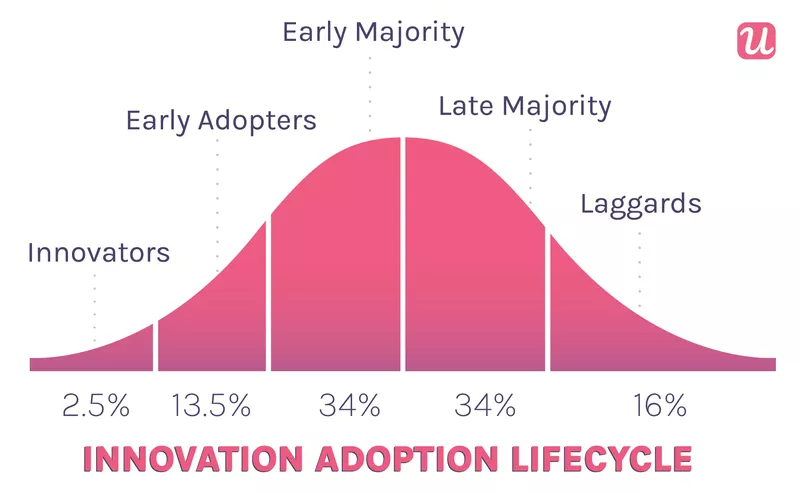
The product adoption curve, also commonly referred to as the technology adoption lifecycle is shaped like a bell curve because markets adopt innovative products non-linearly.
Product adoption starts slowly because innovators are the smallest segment. Technology adoption then speeds up through the early market.
Finally, it decelerates toward the end of the product’s lifecycle where the late majority and laggards are.
Five stages of the product adoption curve
The five distinct stages of the product adoption curve are:
- Innovators
- Early Adopters
- Early Majority
- Late Majority
- Laggards
The order of the stages matters. Think of it as a five-course meal—you have to go in order if you want to stuff as much as possible into your belly (or capture as much of the market as possible.)
There’s just one catch. There’s a chasm between the second and third stage according to Geoffrey A. Moore, author of Crossing the Chasm.
It’s due to a fundamental difference between what the early adopters and the early majority want in a new product. Crossing the chasm is hard, but necessary for mainstream adoption.
Before we peer into the charm, let’s take a closer look at the different technology adoption stages.
Product adoption curve stage 1: Innovators
The very first adopting segment is the innovators, who make up just 2.5% of the market. They’re technology enthusiasts and thrive off being among the first in the technology adoption process.
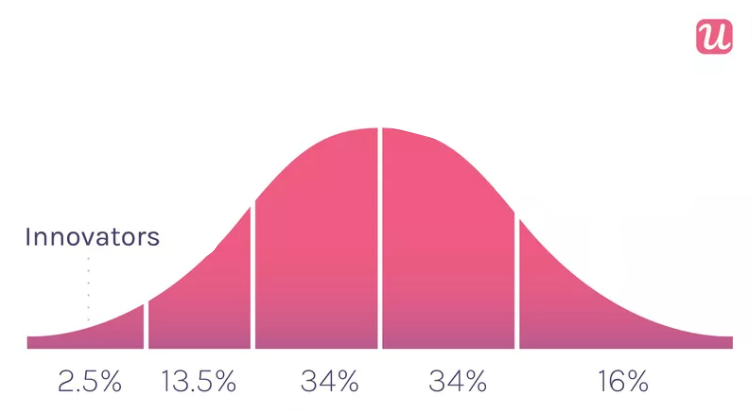
Innovators don’t care too much about bugs or missing features. They’re risk-takers and care about being the first to try an unproven product. This makes them a great source for early feedback.
However, their enthusiasm is fleeting because they move on quickly. So they won’t pay premium prices and prefer to try products at a discount or for free.
Understanding the innovator segment is crucial for businesses, as they provide valuable feedback, help refine the product, and serve as advocates to attract the early majority and other user segments.
Engaging innovators effectively can accelerate the product’s adoption and set the stage for broader market acceptance.
How to improve product adoption among the innovators
Throw an early version of your product to the innovators before perfecting it and use the insights for product development.
Focus your value proposition on how your product is unique and give these innovators free trials and discounts. Creating a sense of exclusivity works well for this group so consider giving them invite-only access.
Product adoption curve stage 2: Early adopters
Next in the product adoption stages are the early adopters, who represent 13.5% of the market. Unlike the innovators, they’re trying to solve a real problem and have access to capital for innovation. They’re often thought leaders in their space and look for disruptive innovation.
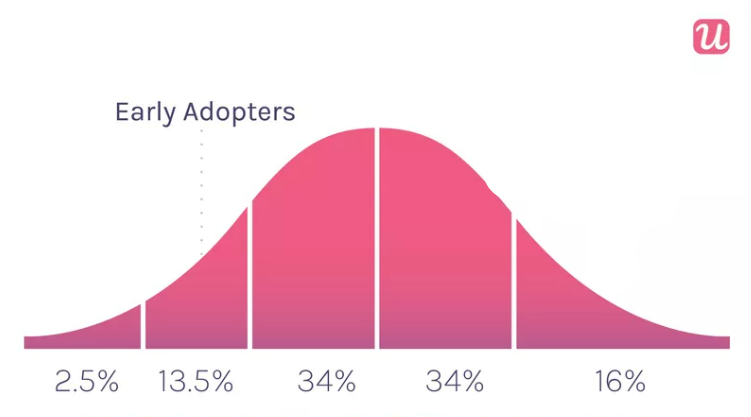
Think of an early adopter as a trendsetting individual rocking AirPods in 2016 back when the idea of wireless headphones was anxiety-inducing.
As visionaries, early adopters are easy to convince there’s a better way. But they’re not quite as risk-loving as innovators and need positive reviews from innovators before adopting new technologies and products.
Since early adopters are trying to solve a real problem, they’re less tolerant of technical issues or missing product features. They need more support and expect a lot of customization, all of which makes them rather demanding.
How to improve product adoption among the early adopters
Use the innovators’ feedback to greatly improve your product for early adopters and reduce time-to-value. These folks are attracted to high-risk and high-reward value propositions that highlight customization and support.
Involve early adopters before your launch and show them the inner workings of the product. This will get them excited and entice them to share your product through their thought leadership.
Product adoption curve stage 3: Early majority phase
The early majority make up a whopping 34% of the market. But unlike innovators and early adopters, they like business continuity and don’t want to pioneer new technology. This is a big shift in attitude and exactly why the chasm exists.
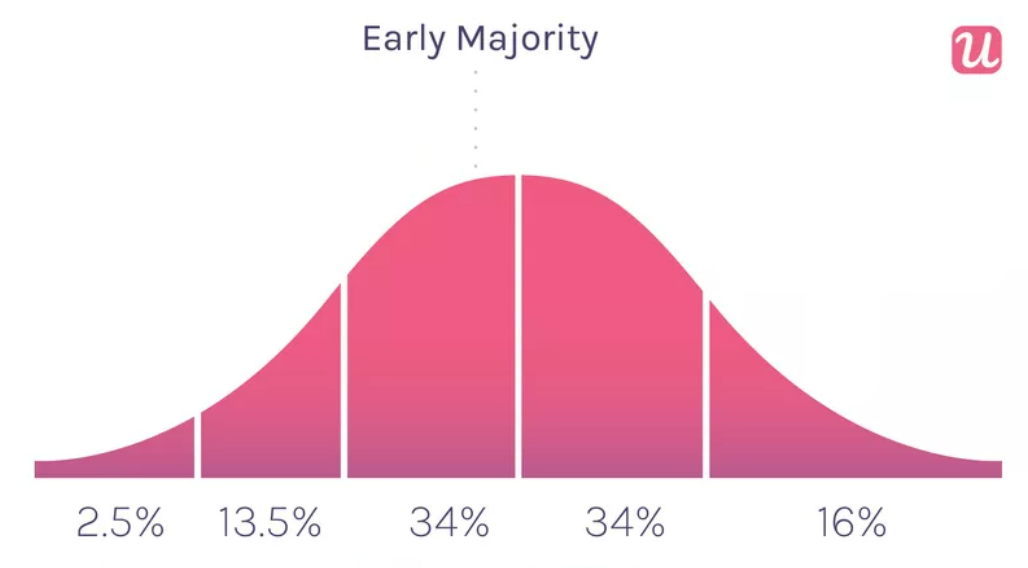
The early majority is also slower at making decisions and prefers to let others thoroughly test new products. They rely on good references from existing users’ success stories with a product before deciding to buy it.
The challenge is that they mainly communicate with each other and less with early adopters. This is frustrating, especially since early adopters are the very segment that’s best able to provide them with positive references!
As a result, this is where many product innovations fail, according to Moore in Crossing the Chasm.
Once you do cross the chasm, you’re rewarded with a user base full of loyal customers and a sign of product/market fit. It’s also where you have the greatest potential for growth and an increase in market share.
How to improve production adoption among the early majority
Based on all prior feedback, find out what pain points to address with this group (e.g. long installation, complex workflows.)
Maximize the value of your product for your primary target market by prioritizing the addition of carefully selected new features that are exceptionally relevant to the early majority’s pain points.
The early majority cares how popular a product is. Find ways to improve your product’s observability with customer success stories. Marketing campaigns and press releases will also help establish your expertise and strong market share.
Product adoption curve stage 4: Late majority adopters
The late majority is next to adopt a product. In terms of adoption rates, the early and late majorities are usually roughly equal, around 34%. Now we’re at the peak of the product adoption curve, where the early majority and late majority intersect. Things start to slow down a little here.
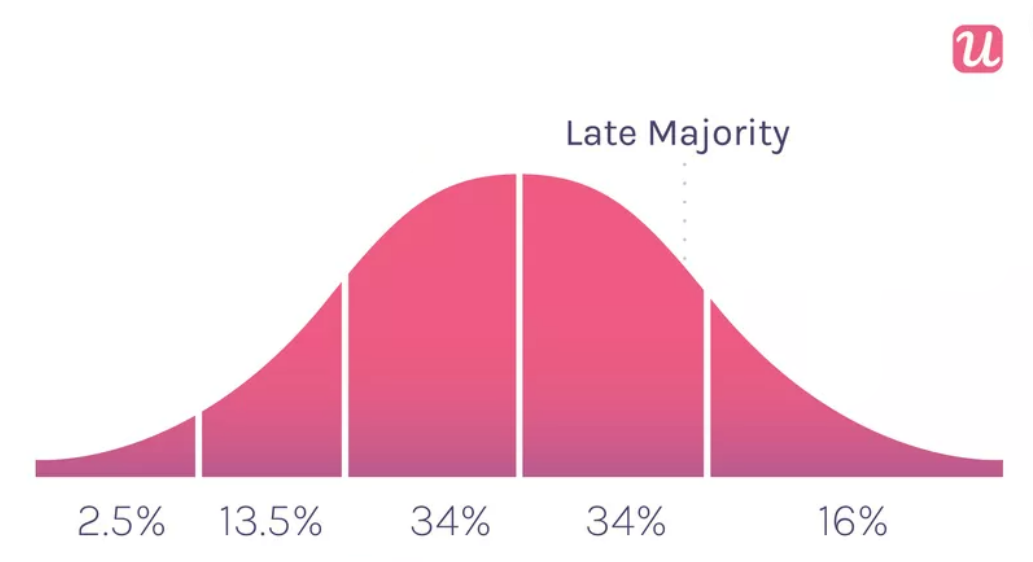
Consumers in the late majority phase are conservative. They don’t actively seek out change because failed innovation can be quite costly to them. They also don’t have big budgets for new products.
Although users in the late majority group don’t like change, they recognize failing to adopt popular products can put them at a competitive disadvantage. And they don’t like that. So they adopt new products out of necessity, not curiosity. But only ones that are tried and tested well.
An example of this is a small business putting itself on Google Maps so it doesn’t lose business to competitors already on Google Maps.
How to improve product adoption among the late majority
Combat the late majority’s apprehension by showcasing a seamless transition to your product. Let them know which of their competitors are successfully using your product. This will show them how not using your product can become a competitive disadvantage.
At this point, it’s important to increase awareness and fight objections.
Product adoption curve stage 5: Laggards
Laggards are the last adopting segment and makeup 16% of the market. They’re usually older and less comfortable with technology. For this reason, they value traditional ways of doing things.
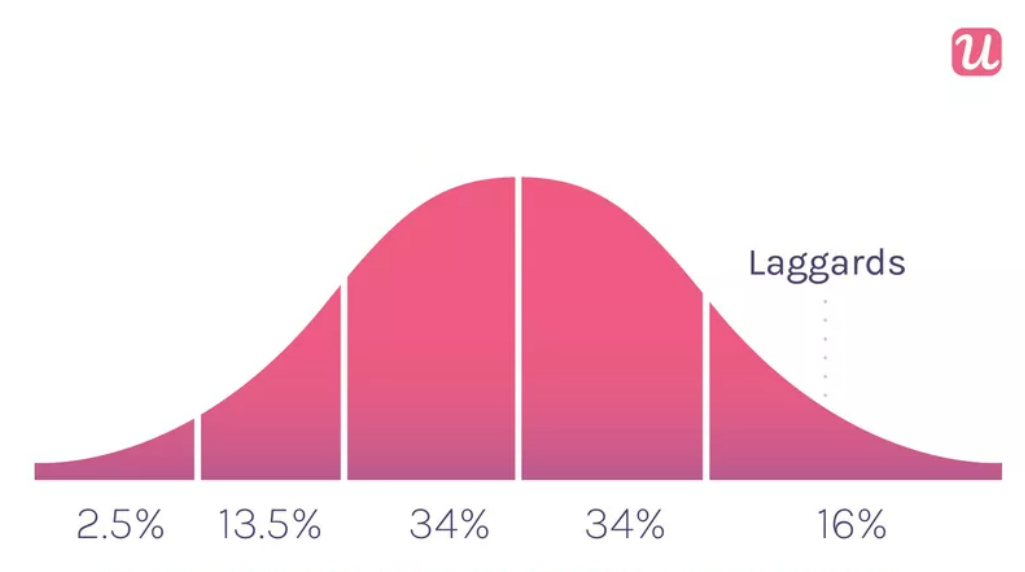
As skeptics, laggards resist change more than any other segment. They’ll eventually cave but only when not using a new product makes life unbearably difficult for them. Or once their traditional alternatives are no longer available or acceptable.
A great example of a laggard is my old man. He finally gave in to buying a pair of Sketchers in 2021. But – only after watching my mother and I flaunt these shoe pillows for over fifteen years.
When laggards finally come on board, a product is already in decline. But they’re no small segment, making up as much of the market as innovators and early adopters combined. Ignoring them may rob you of a decent amount of revenue and market share.
How to improve product adoption among the laggards
Laggards need a lot of hand-holding because they’re skeptical of new products and not as comfortable with technology. Your adoption strategy should include ditching self-service and doing real-time product demos or personal webinars instead. Implement in-app messaging to improve the onboarding process.
Explain how their existing alternatives are making their life extremely difficult. And use reviews and testimonials from people just like them to ease their doubts. And be very patient.
Product adoption curve: Crossing the chasm
For numerous companies, particularly those operating in the B2B and enterprise SaaS space, crossing the chasm represents a tough challenge as it marks the division between visionary early adopters and pragmatic mainstream users.
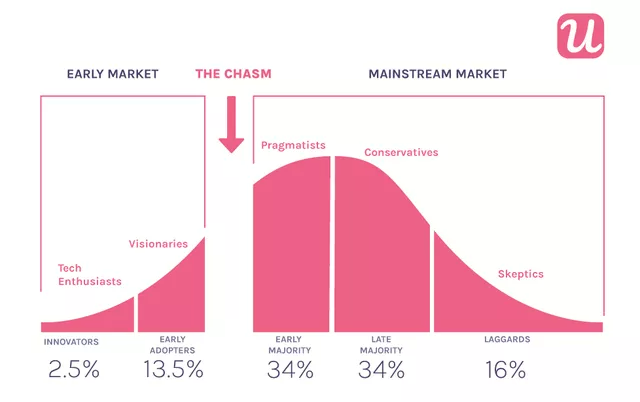
How to cross the chasm
To successfully cross the chasm, it is crucial to maintain a laser-like focus on addressing a specific pain point within a single market. By honing in on this singular pain point, you can effectively tailor your messaging and product offerings to resonate deeply with your target audience.
Furthermore, leverage all available evidence of momentum and growth to instill confidence in potential customers and investors. Highlight key milestones, customer success stories, and market traction to demonstrate the viability and potential of your solution.
To solidify your position, ensure that your single most important feature operates flawlessly at scale.
Prioritize rigorous testing and quality assurance to eliminate any bugs or performance issues that may hinder adoption. This focus on reliability and scalability will build trust and credibility among your target market.
How to use the product adoption curve for product management
As a product manager, you must be able to understand where every customer is on the product adoption curve. But most importantly, you need a clear picture of the user persona for your early adopters.
They’re the most value-sensitive group and the first segment to use your product to solve a real problem. Pleasing them is critical if you want to put your product on the trajectory for product/market fit.
The best way to gain an understanding of your early adopters is to conduct detailed customer discovery interviews. Focus on their particular use case and the specific problem they’re trying to solve.
As the gatekeepers of innovation, they’re notoriously difficult to please. However, pleasing them will prove the value of your product and win you the influence of their thought leadership.
You can increase your chances of developing a product that’s successfully adopted by the market by considering the five subfactors of product innovation.
Five subfactors of product innovation
Rogers breaks down product innovation into five subfactors:
1. The product’s advantage: How the product improves customers’ lives (the value proposition.) This usually involves saving customers time or money, reducing inconvenience, or reducing danger, among many other things.
2. Product compatibility: How well a product fits into users’ existing behavior. Things like switching costs or having to educate users on a new workflow can negatively impact adoption.
3. Product complexity: The time and effort it takes users to get value out of a product. This could include making installation and configuration easier or customizing the experience for new users, active users, and power users.
4. Product trialability: How easily users can try a product before they buy it. This could be either through a freemium model, free trials, or a proof-of-concept demo.
5. Product observability: Whether users are able to observe others get value from the product. This may include branded banners on freemium products or customer success stories.
A word of caution from Moore in Crossing the Chasm: Don’t fall into the trap of giving in to the early market’s every demand. You’ll end up developing a relatively custom product that can’t be used by other customers.
How to use the product adoption curve for product marketing
As a product marketer, you need to learn as much as possible about the user persona at every stage of the product adoption curve. It’ll let you carefully tailor your go-to-market strategy for every segment. You can then build in-app onboarding experiences for every segment and monitor how they’re adopting your product.
The goal of a product marketer is to cross the chasm between the early adopters and the early majority. You need to swiftly pivot your messaging from how your product is a “change agent” to how it’s a “productivity improvement”, according to Moore in Crossing the Chasm.
The best product adoption tools
Let’s take a look at the best product adoption tools designed to revolutionize the way businesses onboard users, drive adoption, and maximize product success.
Userpilot – for driving product adoption with in-app experiences
Userpilot is a tool for product teams to increase growth along the user journey through personalized in-app experiences.
Among Userpilot’s range of powerful features, you will find:
- Different UI patterns: Userpilot allows businesses to create interactive and guided onboarding experiences for their users. These experiences can include tooltips, slideouts, modals, and banners that help users understand and navigate the product more effectively.
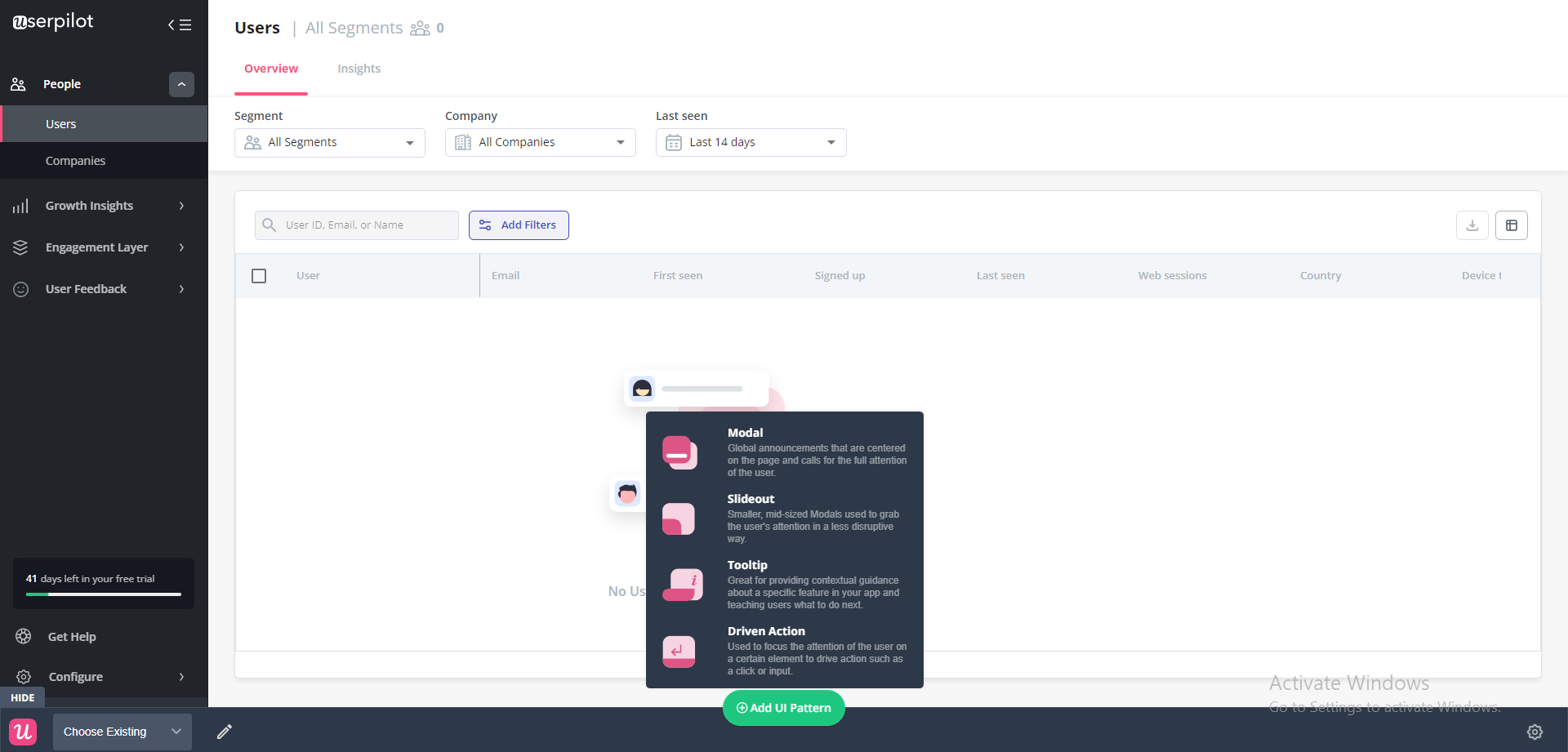
- Onboarding checklists: With Userpilot, businesses can build checklists that guide new customers to use specific features or accomplish certain tasks.
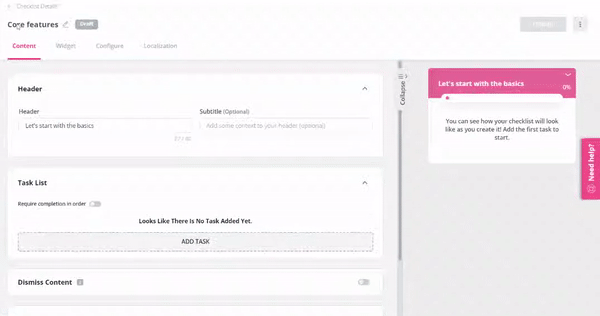
- In-app messaging and surveys: Userpilot enables businesses to send targeted in-app messages and surveys to gather feedback and user insights (e.g. measure customer engagement score). These messages can be triggered based on user behavior or specific events, allowing companies to gather valuable information and make data-driven decisions to enhance the user experience.
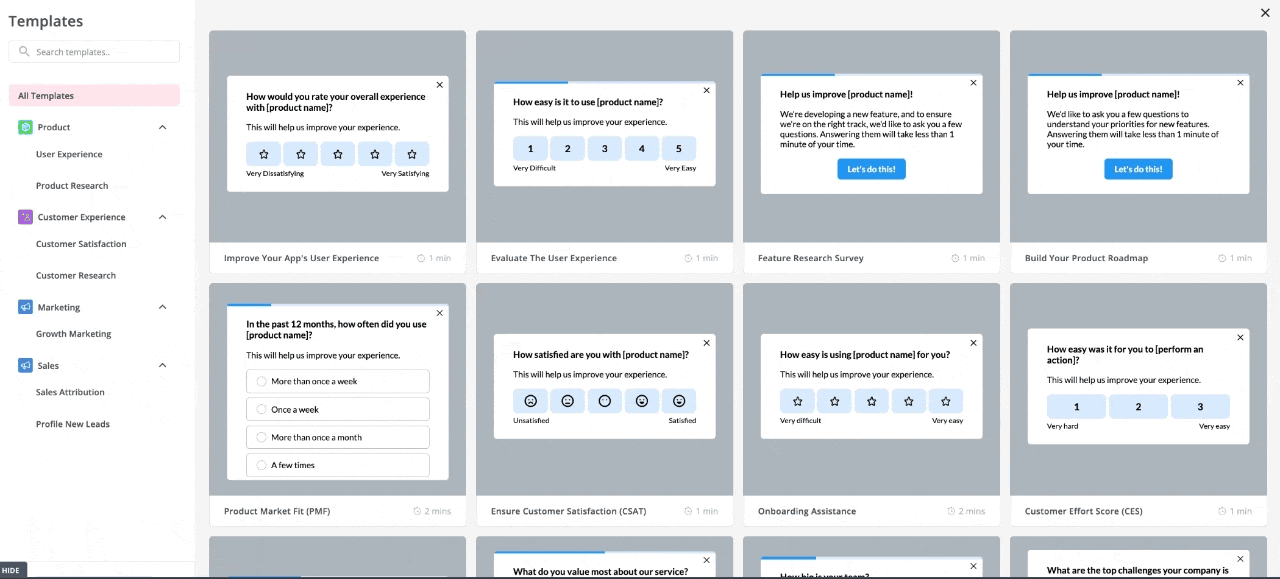
- Personalization and Segmentation: Userpilot allows businesses to personalize the user experience by delivering customized content and experiences based on 6+ user segments. This personalization helps to address specific user needs and increase user satisfaction.
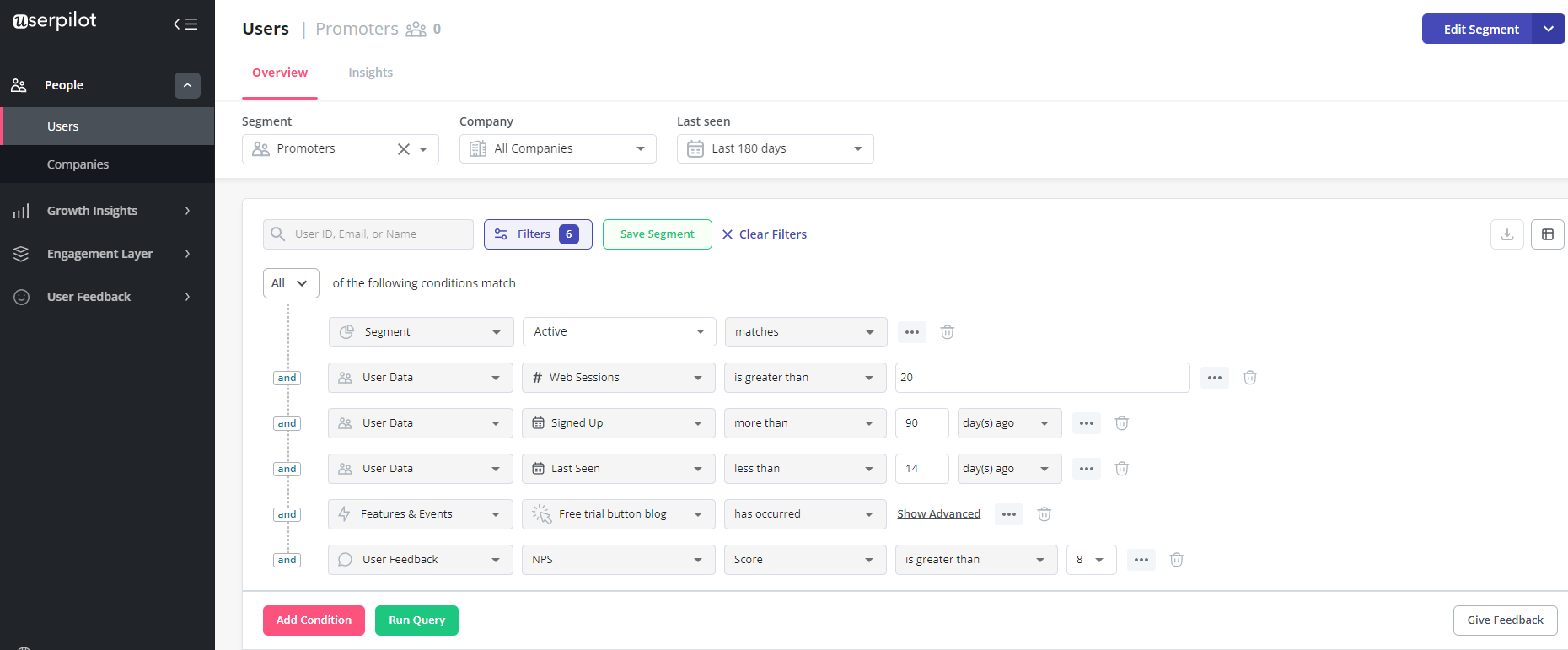
- Analytics and Insights: Userpilot provides comprehensive analytics and insights into user behavior, engagement, and adoption rates. SaaS businesses can track user interactions, identify bottlenecks in the user journey, and gain actionable insights to optimize their product and improve adoption rates.
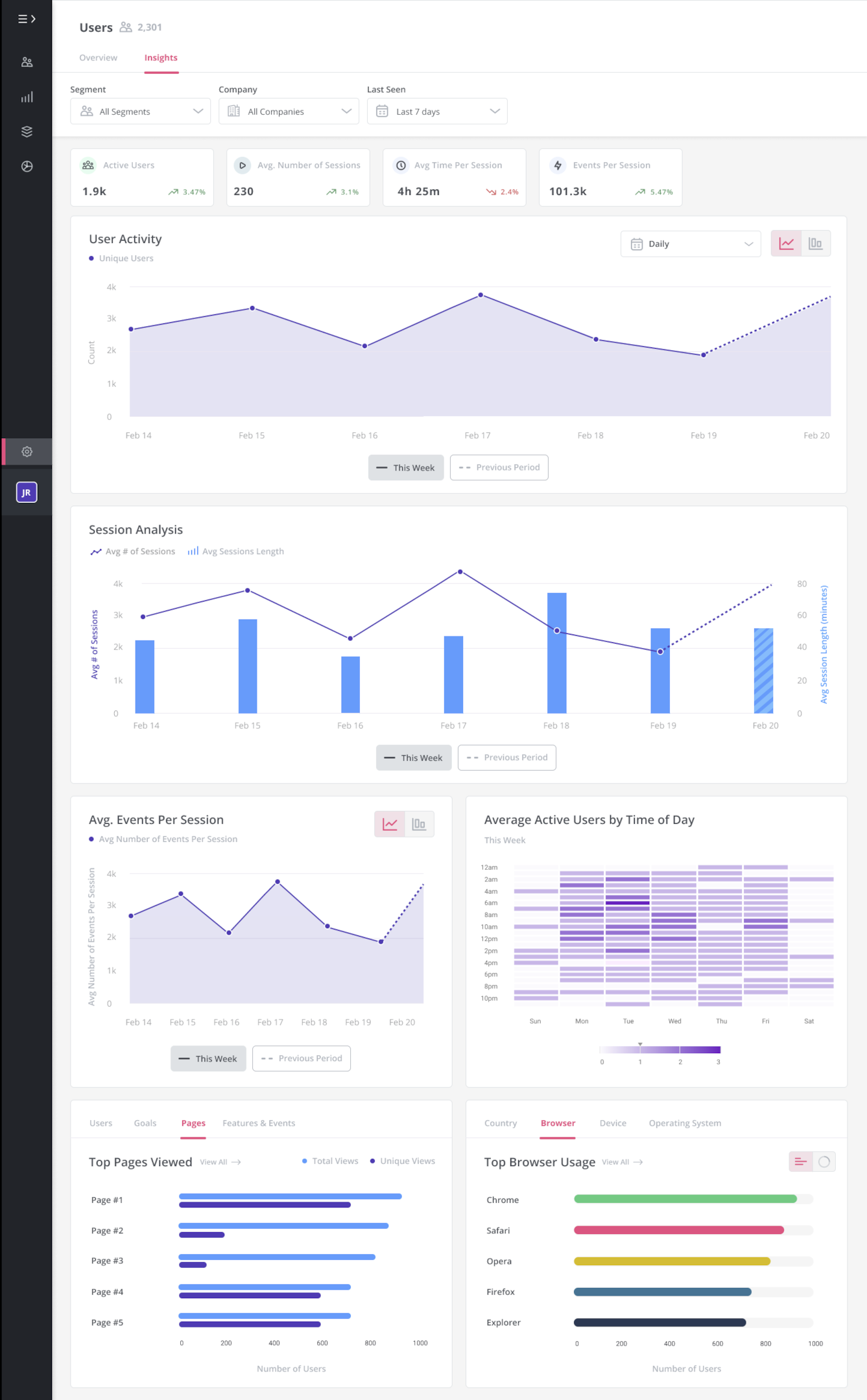
If you’re looking for a practical solution to increase product adoption for your SaaS, get a Userpilot demo today!
Heap – for discovering additional necessary steps to improve product adoption
Heap is a standalone product analytics tool. It tracks everything your users do as soon as it’s installed and without needing to be configured. It’s more convenient than tools like Mixpanel in which you have to set your events up first.
The Heap Illuminate feature finds opportunities for a better user experience. It does this by automatically pinpointing steps where users are dropping off. Use this to see where users need more hand-holding to adopt your product as quickly as possible.
Heap is effective but not cheap. Paid plans start at $1,000 per month, while the free plan is limited in usage and features.
Conclusion
Understanding who your target customer is is great. But getting a handle on where they sit on the product adoption curve is critical in knowing how to engage each segment throughout your product lifecycle.
And don’t forget to account for the terrifying chasm between the early adopters and the early majority. Carefully craft your strategy so you’re giving early adopters what they need without sacrificing having a product that’s universal. As you hit the early majority phase, quickly pivot your positioning so you don’t fall into the chasm.
If you want to get more users to adopt your product with in-app onboarding, get a Userpilot demo.


